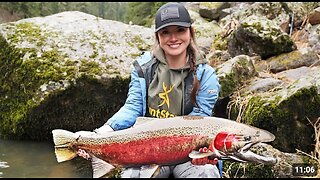Premium Only Content

The Great Green Heron
The great green heron
Identification
The Great Green Heron (Butorides virescens) is a small, dark heron with a distinctive appearance. From a distance, it appears as a dark, stocky bird hunched on slender yellow legs at the water’s edge, often hidden behind a tangle of leaves. Up close, it reveals a striking bird with a velvet-green back, rich chestnut body, and a dark cap often raised into a short crest.
Physical Characteristics
Length: 16-22 inches (41-56 cm)
Weight: Not specified
Plumage: Dark green back, chestnut neck and body, dark cap
Legs and feet: Yellow
Bill: Dagger-like, dark gray
Habitat and Behavior
Found in riparian zones, wetlands, ponds, lakes, and human-made canals and ditches
Prefers dense vegetation and often crouches patiently to surprise fish with a snatch of its bill
May use small items as bait to lure in fish
Forages both diurnally and nocturnally, adapting to the rhythm of the tides
Intolerant of other birds, including conspecifics, when feeding and does not forage in groups
Diet
Mainly eats small fish, frogs, and aquatic arthropods
Also takes invertebrates and vertebrate prey, including leeches, earthworms, dragonflies, damselflies, waterbugs, grasshoppers, spiders, crayfish, prawns, mice, other rodents, lizards, tadpoles, and snakes
In urban areas, may eat goldfish
Breeding and Nesting
Pairs usually nest on their own, although sometimes a few pairs will nest near each other
Nests are often found in isolated small ponds or areas with dense vegetation
The species is known to be intolerant of other birds, including conspecifics, when breeding and nesting
Call and Vocalizations
Loud and sudden “kyow” call
Series of more subdued “kuk” calls
During courtship, males give a “raah-rahh” call with wide-open bill, make noisy wingbeats, and produce “whoom-whoom-whoom” calls in flight
May also call “roo-roo” to females before landing again.
-
 11:05
11:05
Hannah Barron
21 hours agoFirst STEELHEAD Trip!
9.65K8 -
 1:00:13
1:00:13
Trumpet Daily
19 hours ago $3.98 earnedThe World Realigns Against America - Trumpet Daily | Mar. 31, 2025
7.69K14 -
 11:08
11:08
This Southern Girl Can
12 hours agoDIY Spring Wreath
8.13K3 -
 3:04:40
3:04:40
Danny Polishchuk
17 hours agoLiberation Day Looms + Guest Richard Syrett Talks JFK Files | Low Value Mail Live Call In Show
53.1K23 -
 2:40:15
2:40:15
Barry Cunningham
11 hours agoPRESIDENT TRUMP SIGNS NEW EXECUTIVE ORDERS AND THE EVENING NEWS!
51.1K53 -
 2:49:55
2:49:55
TimcastIRL
11 hours agoGOP Office TORCHED, Terror Suspected, Elon Says ARREST Dem Funders w/Winston Marshall | Timcast IRL
223K111 -
 1:39:42
1:39:42
Glenn Greenwald
13 hours agoMajor Escalation in Attempts to Purge U.S. Universities of Israel Critics; Who are the Israel Groups Providing Lists to the U.S. Government to Deport & Punish? | SYSTEM UPDATE #431
207K200 -
 9:21:30
9:21:30
SpartanTheDogg
16 hours agoPro Halo Player
71.9K3 -
 1:08:55
1:08:55
Donald Trump Jr.
17 hours agoGlobalist Panic & Populist Prosperity, Live with Natalie Winters & Alex Epstein | Triggered Ep229
189K157 -
 1:37:15
1:37:15
CocktailsConsoles
9 hours agoBE PART OF THE GAME!!| Death Road to Canada | Cocktails & Consoles Livestream
49.2K4